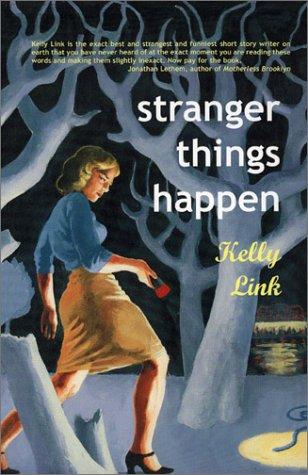 In the following article, “How Feminist Are Fractured Fairy Tales?” Dr. Hilary Crew discusses the contemporary trend of recontextualizing fairy tales and the potential feminist function of these so-called “fractured fairy-tales.” As Kelly Link’s collection contains numerous examples of this type of writing, this article might be a valuable tool in reading and interpreting these stories. I have posted the article below, and you can read it on the original site here.
In the following article, “How Feminist Are Fractured Fairy Tales?” Dr. Hilary Crew discusses the contemporary trend of recontextualizing fairy tales and the potential feminist function of these so-called “fractured fairy-tales.” As Kelly Link’s collection contains numerous examples of this type of writing, this article might be a valuable tool in reading and interpreting these stories. I have posted the article below, and you can read it on the original site here.--------
One of my favorite books as a child was a paper-bound copy of Grimm's fairy tales. I read and re-read them, enjoying some more than others, but those stories have become part of my own fantasies and imagination. The stories collected and re-written and edited by the Brothers Grimm have come from a long tradition of oral story-telling and in that tradition are constantly being re-told, adapted, embellished, and re-contextualized into other forms. Fracturing fairy tale is a contemporary variant of what has been always done in fairy tales in that story is changed in some way--except that this term is usually associated with questions of gender representation.
Feminist criticism and re-visioning of fairy tales has centered on exposing the gender ideology that is perpetuated in tales. Criticism has focused on the passivity of young girls waiting to be rescued, the encoded binaries in a text that equate beauty with goodness, the representation of evil stepmothers, and the closures which seal a girl's dependency on a prince. I would particularly, like to raise questions of what kind of changes are being made in regard to picture book versions of `fractured' fairy tales.
A number of different approaches are used. In her parody, Prince Cinders (New York: Putnam, 1988), for example, Babette Cole changes story by altering point-of-view, reversing gender roles, and by fracturing the portrait of the ideal, handsome prince. Another approach has been to fracture gender role expectations in original tales that use the narrative plot form and conventions of traditional fairy tales. Jay William's Petronella (New York: Parents' Magazine Press, 1973) is an interesting older example. Katherine Paterson addresses gender equity in her original tale, The King's Equal (HarperCollins, 1992). In looking at re-tellings of tales such as these, I wonder to what extent they fracture ideologies of gender and beauty that have been encoded into traditional tales. Do these stories go beyond merely reversing gender roles? Are there ways in which these alternative stories might be considered feminist texts? In relation to thinking about feminist approaches to fairy tale in picture books, there are, I think some basic questions we can ask in relation to re-tellings that purport to fracture or change traditional tales in some way:
* In what ways and to what extent has fairy story been changed when compared to a well-known traditional version of the tale? For example, what kind of changes have been made at a textual level and also at a narrative level such as point-of-view? What narrative techniques are being used in re-tellings to draw readers' attention to the way tales have been changed to an alternative story?
* To what extent do re-tellings of fairy tales set in contemporary contexts reproduce expectations of traditional gender roles and closures of fairy tale? One might look, for example, at Frances Minter's Sleepless Beauty (New York: Viking, 1996).
* In what ways are representations of female protagonists different in `fractured' tales from traditional tales in regard to issues such as self-determination, self-expression, body image? In what ways are these `different' female (and male) coming-of-age stories?
* In what way do illustrations contribute to a `fractured' tale? Are re-representations of gender roles, for example, appropriate to the particular historical or cultural context which is defined or is identifiable through the kind of illustrations that accompany text?
* To what extent are there changes made to representations of stepmothers, witches, and crone figures? Do stories change representations of other relationships that have been imagined in formulaic ways in some traditional tales--the relations between stepmothers and daughters, for example. Are mothers or other women valued in the text? Charlotte Huck's Princess Furball (New York: Greenwillow, 1989), while not strictly a `fractured' re-telling, is an interesting example that could be discussed in relation to some of these questions.
* Can we recognize a changing set of values and ethics encoded into `fractured' tales through changing narrative conventions of traditional fairy tale? On what qualities is value placed?
* While variants of fairy tales from other cultures fall into a very different category they, too, provide alternative experiences of fairy tale, and it can be useful to think how one might discuss these in relation to some of the questions above. Penny Pollock's The Turkey Girl (Little, Brown, 1996), a Native American variant of Cinderella and Ed Young's Lon Po Po (New York, Philomel, 1989), a Chinese variant of Red Riding Hood, are interesting examples to think about.
* Other questions that can be raised are about how young children respond to these stories. How much, for example, is the recognition of a story's `difference' dependent on a child's recognition of the narrative form of fairy tale or a particular version of a tale?
I believe in the magic and power that fairy stories have in shaping our own and children's imaginations and fantasies. I take delight in discovering the different ways in which stories have been re-visioned but I think it important to discuss just in what ways `fractured' tales produce alternative meanings and experiences for children.

No comments:
Post a Comment